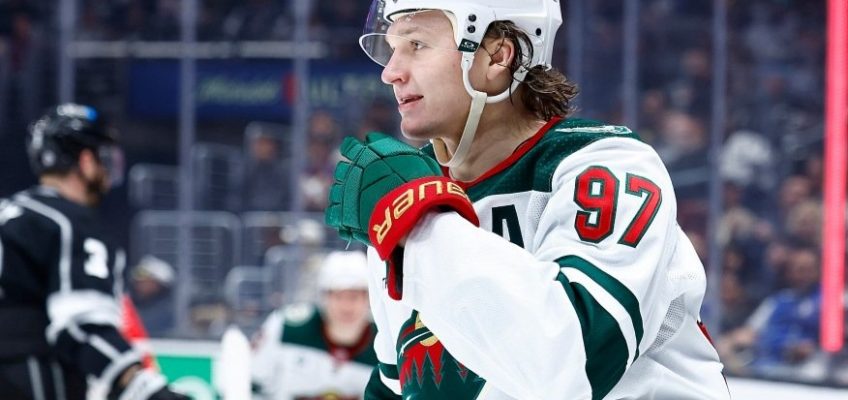Bill Guerin rarely minces his words, and the Minnesota Wild general manager didn’t pick last week to start. When announcing the signing of star forward Kirill Kaprizov to a record eight-year contract worth $17 million per season, Guerin was asked if it was the most important deal in the 25-year history of the franchise.
“Yes, very much so,” he said.
There are not many questions about the impact Kaprizov can have on the ice. He is renowned as the most dynamic and talented player employed by the Wild since they entered the league as a 2000 expansion team. Since he joined the team for the 2020-21 seasons, he has been the team’s leading scorer (185 goals, 386 points).
If there are questions about the deal, they come not regarding goals and assists, but in the realm of dollars and cents, and what having the NHL’s biggest contract ever on their books will mean for the Wild. History tells us that taking big swings and making big investments in the future is exciting, and can be risky.
Fiscal fireworks
Prior to last week, unquestionably the biggest off-ice moment in Wild history came on July 4, 2012. On that hot, steamy Independence Day, then-Wild general manager Chuck Fletcher landed the two biggest fish available in the NHL free agent waters when forward Zach Parise and defenseman Ryan Suter agreed to identical 13-year, $98 million contracts.
Those salaries, with their average annual value of $7.5 million, were high for the time, but not ridiculously so — especially for a team that had missed the playoffs in each of the preceding four years and was clearly in need of a notable spark. The trouble with numbers stemmed from the lengths of the contracts, which in theory had them playing in Minnesota until 2025.
To most, it seemed like a good idea at the time, and in the short term, the Wild became an every year playoff team thanks in large part to the work of that duo. They even got to the second round of the playoffs, twice, and won two second-round games for the first time since 2003.
But there were no parades to commemorate the achievement, and by the summer of 2021 — with the players aging, their production slipping, and talk of a tense locker room — Guerin bought out what remained of their contracts. They were off the roster, but not off the books.
The four years that remained on those contracts followed the franchise in the form of a salary cap hit, and during the ensuing trade deadlines and free agency periods in 2022, 2023 and 2024, Guerin lacked the cap space to do much of anything.
The new money
In November 1989, the Minnesota Twins made, at the time, the biggest salary splash in the history of Major League Baseball by making outfielder Kirby Puckett the league’s first $3 million player. The milestone didn’t even last a full year, as Oakland slugger Jose Canseco was making $4 million a season by June 1990.
Similarly, Kaprizov’s contract will not be a record forever, with the likes of Jack Eichel, Kyle Connor and Connor McDavid all due for new deals within the coming year. And while the combined contracts of Parise and Suter claimed roughly one-fourth of the Wild’s salary cap space in the 2012-13 season, when teams could spend no more than $70 million on players, the cap for the current season is $95.5 million — and it’s expected to be $104 million in 2026.
That means Kaprizov’s salary, as history-making as it is, will comprise roughly 15 percent of the team’s salary cap. And unlike the constraints on Guerin when he was still paying Parise and Suter, he made it clear that Minnesota is still solidly in the game for free agents and trades as they plan to build around the Russian star.
“It doesn’t stop here. That’s something that we talked about. We want to win. We want to do the things that you have to do in order to win,” Guerin said. “So, you know, somewhere down the line, start to add pieces or change where necessary, or whatever. … We haven’t been able to be in the game because of our cap situation, but now that’s passed.”
That was a refrain Wild fans also heard back in July 2012. When Parise and Suter were introduced, they talked of being the first of many big name free agents who would want to work, live and win in Minnesota. Parise even suggested that they would be “recruiters,” spreading the word that the Wild sweater would be the hot fashion item for the top players of the 2010s.
It didn’t happen for various reasons, not least of which was that under the salary cap of the time, the Wild simply didn’t have the money to significantly build around their new stars. Perhaps the biggest-name free agent the Wild signed during the Parise/Suter era was former Gophers star Thomas Vanek before being bought out. But he lives here in retirement and was one of the coaches that helped Stillwater High School make a run to the boys state title game last season.
With those history lessons learned, there seems to be a determination, and financial flexibility, to do it better this time around.
Related Articles
Questions remain as Wild’s preseason comes to a close
Jesper Wallstedt feels ready for Wild’s backup goalie role
Kirill Kaprizov show rolls on as Wild rally in preseason home finale
St. Paul renames 7th Street ’97th Street,’ temporarily, for Wild star Kirill Kaprizov
Wild’s Mats Zuccarello sidelined 7-8 weeks with lower-body injury


Leave a Reply